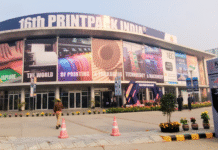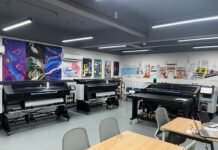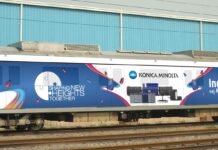At IGAS 2022 in Tokyo last week, Fujifilm Business Innovation unveiled a new cut sheet dry toner press tentatively called the B2 Revoria, that will target commercial print applications as well as photobooks, catalogs and transpromo.
This takes a 750 x 662mm sheet that’s able to print six A4 pages or 28 postcards (which is a popular format in Japan). It will take a wide range of media from 64 to 450gsm, including coated paper, plain paper and non-woven materials.
The print resolution is 1200 x 1200 dpi at 10-bit. Fujifilm says that this translates into 2400 x 2400 dpi. It’s said to use a new method of charging and distributing toner uniformly over the sheet to cope with the larger sheet size. It can produce 2,500 B2 sph or at least that’s the plan now though I’m told the machine is still not finalized. Naturally this speed is for single-sided printing and the speed halves for duplexing. The target is for a monthly volume of 300,000 B2 sheets.
The current version prints CMYK but there is space for two further colors, with Fujifilm looking at gold, silver, white, clear and a pink that’s said to be almost fluorescent. This should give users a good range of options for competing for higher value jobs.
The B2 Revoria uses a two step fusing process. First, there’s a Far InfraRed system to apply a low temperature fusing, and this is then followed by a drum to apply low pressure. There’s a camera system to control front to back registration and Fujifilm is planning to add an in-line spectrophotometer to maintain the color accuracy throughout a production run.
It’s also worth noting that the press is said to be very intuitive to operate with little training required. That should give owners a degree of flexibility in assigning staff and will cut the training bill.
Naturally there’s no word on pricing yet though this will be a further differentiator between the two models. Fujifilm says it is still studying the service charging and acknowledges that commercial printers don’t generally like click charges. However, it’s difficult to see how Fujifilm can get around this unless the press has been designed and built in such a way that the operators – who might not have much training – can easily judge when to replace parts and carry out that replacement themselves.
The B2 Revoria will also be sold in the UK and Europe, where it will be positioned between the existing Revoria PC1120 and the Jet Press 750HS. That said, the smaller PC1120 is only sold in a limited number of countries in Europe and is not yet available in the UK. This begs the question of whether or not Fujifilm is planning on expanding the sales of the PC1120. Fujifilm was forced to develop the Revoria brand when its previous arrangement with Xerox collapsed in acrimonious circumstances.
This means that Fujifilm will now be selling two B2 cut sheet digital presses, the inkjet Jet Press 750 and this new dry toner Revoria. Fujifilm says that the Jet Press has better image quality and is faster though I think that the Revoria will have an edge for short run double sided printing. Fujifilm expects that the dry toner device will mainly compete on offering a broader range of media.
The samples from the B2 Revoria that were shown at IGAS were extremely good with the sharp vibrant images that you would expect from a top-end electrophotographic press. The press is clearly designed to take some market share from the B2 Indigo machines.
For now, the B2 Revoria has been shown at IGAS as a prototype, where it was kept behind a barrier on a corner of the stand. Fujifilm is hoping to start beta testing in the first half of next year and to have it available commercially in the second half of 2023. You can find further details on Fujifilm’s current line-up but not yet the Revoria B2 from fujifilm.com.
This article is republished with permission from www.nessancleary.co.uk.
















